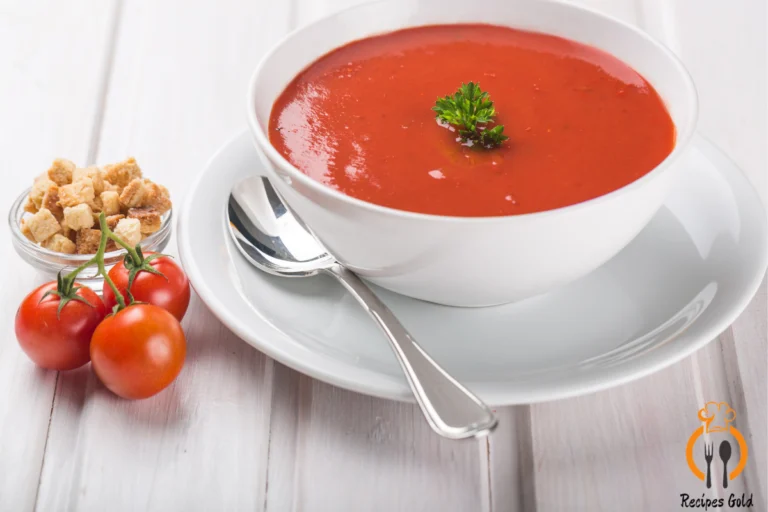Tomato Soup Anti-Inflammatory Benefits: Unlocking Health Secrets
In the quest for a healthier lifestyle, the spotlight often lands on the foods we eat and their impact on our body’s inflammation. Among the myriad of dietary choices, tomato soup emerges as a comforting classic with potential health benefits that extend beyond its warm embrace. This article delves into the heart of the matter: Is tomato soup anti-inflammatory? We’ll explore the nutritional profile of tomatoes, the anti-inflammatory properties of tomato soup, and how incorporating this delicious dish into your diet can contribute to your overall well-being. So, let’s ladle into the science and savor the flavors of health one spoonful at a time.
Introduction to Tomato Soup and Inflammation
Ah, tomato soup – it’s not just a cozy comfort on a chilly day but might just be a hero in the culinary world of health. Now, you might be wondering, how does this all tie into inflammation? Well, let me tell you, it’s a topic hotter than a pot on the stove!
The Role of Diet in Managing Inflammation
First off, let’s get a handle on inflammation. It’s not all bad; in fact, it’s your body’s way of saying, “Hey, I’m fighting off some nasties here!” But, when it overstays its welcome, it’s like that one guest at a party who just won’t leave, causing more harm than good. Chronic inflammation is linked to a host of unwelcome conditions, from arthritis to heart disease. That’s where diet steps in, wielding its power to either fan the flames or douse the fire.
The Nutritional Composition of Tomatoes
Tomatoes, the star of our soup, are like the superheroes of the vegetable world (though technically a fruit, but let’s not split hairs). Packed with vitamins, minerals, and antioxidants, they bring their A-game to the fight against inflammation. And the MVP among these nutrients? Lycopene, a powerful antioxidant that gives tomatoes their red hue and is a heavyweight in the anti-inflammatory arena.
So, as we simmer down into the depths of tomato soup’s potential health benefits, keep your spoon ready. We’re about to stir through the evidence, ladle out the facts, and serve up a bowlful of knowledge that might just change the way you look at this humble dish. Stay tuned, and let’s dive into the delicious world of tomatoes, inflammation, and the quest for a healthier you.
Nutritional Profile of Tomatoes
Diving deeper into the heart of our vibrant red friends, tomatoes aren’t just a feast for the eyes; they’re a powerhouse of nutrition. Let’s peel back the skin and see what’s inside.
Key Nutrients in Tomatoes
Tomatoes are bursting with vitamins and minerals. They’re like nature’s own multivitamin, offering vitamin C, potassium, folate, and vitamin K. Each bite (or slurp!) of tomato soup delivers a dose of these essential nutrients, supporting heart health, bone strength, and more. Plus, they’re low in calories and high in water content, making them a hydrating choice for those mindful of their intake.
Lycopene: The Anti-Inflammatory Powerhouse
Now, let’s zoom in on lycopene, the star of the tomato show. This potent antioxidant doesn’t just sit back and look pretty; it’s hard at work neutralizing free radicals, those pesky molecules that can lead to chronic inflammation and disease. Studies suggest that lycopene’s anti-inflammatory effects are particularly beneficial for reducing the risk of certain chronic conditions, including heart disease.
But here’s the kicker: lycopene is more bioavailable (that’s science speak for “your body can use it better”) in cooked tomatoes than raw ones. That’s right, making tomato soup might just unlock more of those anti-inflammatory benefits than munching on a raw tomato salad. Plus, adding a little fat, like olive oil, can boost lycopene absorption. Talk about a dynamic duo!
So, as we ladle through the science, it’s clear that tomatoes bring more to the table than just flavor. They’re a nutritional powerhouse, with lycopene leading the charge against inflammation. Next up, we’ll simmer into how tomato soup harnesses these properties to combat inflammation, one delicious spoonful at a time. Stay tuned, and keep that spoon ready!
Tomato Soup and Its Anti-Inflammatory Properties
Now that we’ve got the scoop on tomatoes’ nutritional prowess, let’s pour that knowledge into the pot of our main dish: tomato soup. This section is where the broth meets the bowl, exploring how this comforting classic can be a balm for inflammation.
How Tomato Soup Can Combat Inflammation
Cooking up a storm with tomato soup does more than tantalize your taste buds; it stirs up a storm against inflammation. Remember our friend lycopene? Heating tomatoes transforms them into an anti-inflammatory elixir, making tomato soup a veritable potion of wellness. But the magic doesn’t stop with lycopene. The best tomato soup recipes often include a medley of other anti-inflammatory ingredients like garlic, onions, and herbs, turning your bowl into a cauldron of health benefits.
Moreover, the simplicity of tomato soup allows for the addition of various anti-inflammatory spices, such as turmeric and black pepper, enhancing its healing potential. It’s like each ingredient is a musician in an orchestra, coming together to perform a symphony for your health.
Scientific Studies on Tomatoes and Inflammation
Let’s not just take our word for it; the science speaks volumes. Research has shown that the antioxidants in tomatoes, especially lycopene, play a significant role in reducing markers of inflammation in the body. One study highlighted that individuals consuming tomato products experienced a decrease in levels of specific inflammatory compounds. It’s like each spoonful of tomato soup is a step on the path to reducing the body’s inflammatory response.
But, as with any good story, there’s a plot twist. Not all tomato soups are created equal. The store-bought varieties can be high in sodium and preservatives, potentially offsetting some health benefits. Thus, whipping up your own batch at home lets you control the ingredients, ensuring your soup is not only delicious but also maximizes its anti-inflammatory potential.
As we blend the ingredients and the science, it becomes clear that tomato soup is more than just comfort food; it’s a comforting solution to inflammation. With each simmer, blend, and taste, we’re ladling out more than just soup; we’re serving up health in a bowl. So, next time you’re stirring the pot, remember, you’re not just making soup; you’re crafting an anti-inflammatory masterpiece. Stay tuned as we next explore how to make the ultimate anti-inflammatory tomato soup, ensuring every ingredient counts towards your health.
Making Anti-Inflammatory Tomato Soup
Whipping up a batch of tomato soup that’s not just good for the soul but also for the body involves more than tossing tomatoes into a pot. It’s about choosing ingredients that amplify the anti-inflammatory benefits, turning your kitchen into a lab of healthful concoctions.
Choosing the Right Ingredients for Maximum Benefits
First things first, let’s talk tomatoes. Opting for organic tomatoes can be a step in the right direction, minimizing exposure to pesticides and potentially enhancing the soup’s health benefits. Whether you go for fresh or canned, look for options with no added salt or preservatives to keep things as wholesome as possible.
But the anti-inflammatory magic doesn’t stop with tomatoes. Incorporating ingredients like garlic, onions, and a rainbow of spices not only adds layers of flavor but also boosts the soup’s health properties. Garlic and onions are renowned for their anti-inflammatory and immune-boosting capabilities, while spices like turmeric, with its active component curcumin, can significantly reduce inflammation markers in the body.
Recipe for Anti-Inflammatory Tomato Soup
Now, let’s get to the heart of the matter with a simple yet potent recipe:
- Ingredients:
- 2 tablespoons of olive oil (for healthy fats)
- 1 large onion, chopped
- 3 garlic cloves, minced
- 2 cans (14 oz each) of organic, no-salt-added tomatoes or 2 pounds of fresh, ripe tomatoes, peeled and chopped
- 2 cups of vegetable broth (low sodium)
- 1 teaspoon of turmeric
- A pinch of black pepper (to enhance curcumin absorption)
- Fresh basil leaves for garnish
- Salt to taste (optional)
- Directions:
- In a large pot, heat the olive oil over medium heat. Add the onion and garlic, sautéing until soft and fragrant.
- Stir in the tomatoes, vegetable broth, turmeric, and black pepper. Bring to a boil, then reduce heat and simmer for 20-25 minutes.
- Use an immersion blender to puree the soup until smooth. Taste and adjust seasoning as desired.
- Serve hot, garnished with fresh basil leaves.
This recipe is a canvas, inviting you to paint with your palette of ingredients. Feel free to add carrots for sweetness, red pepper flakes for a bit of heat, or even a splash of coconut milk for creaminess. Each addition not only tweaks the flavor profile but can also enhance the soup’s anti-inflammatory power.
Creating anti-inflammatory tomato soup is like composing a symphony, where each ingredient plays a crucial role in the harmony of health benefits. By choosing the right components and combining them with care, you’re not just cooking; you’re crafting a meal that nourishes the body and delights the senses. Stay tuned as we delve into how to incorporate this healthful dish into an anti-inflammatory diet, ensuring every spoonful contributes to your well-being.
Dietary Considerations
Embracing tomato soup for its anti-inflammatory benefits is a delicious step toward a healthier lifestyle. However, integrating it into your diet with mindfulness can maximize its potential, turning each meal into an opportunity for wellness.
Incorporating Tomato Soup into an Anti-Inflammatory Diet
An anti-inflammatory diet isn’t just about adding the right foods; it’s about creating a symphony of nutrients that work in harmony to reduce inflammation and promote overall health. Tomato soup, with its rich lycopene content and potential for nutrient-packed additions, can be a cornerstone of such a diet. Pairing it with whole grains, lean proteins, and a bounty of fruits and vegetables can amplify its benefits, creating a balanced plate that sings with flavor and nutrition.
But it’s not just about what you add; it’s also about what you avoid. Processed foods, high in sugar and unhealthy fats, can sabotage your anti-inflammatory efforts. By choosing homemade tomato soup over canned varieties laden with sodium and preservatives, you’re not only dodging potential dietary pitfalls but also embracing the full spectrum of nutrients your body craves.
Potential Allergies and Intolerances
While tomato soup can be a vessel of health for many, it’s important to listen to your body’s unique chorus. For some, tomatoes, as members of the nightshade family, can trigger inflammation or intolerance symptoms. If you find yourself in this group, fear not. There are countless other soups and dishes brimming with anti-inflammatory properties that can take center stage in your diet.
Exploring alternatives like butternut squash soup or a hearty lentil stew can offer similar benefits without the discomfort. Remember, the key to a harmonious diet is finding what works for you, ensuring each meal not only nourishes your body but also brings joy to your table.
As we ladle our way through the world of anti-inflammatory eating, it’s clear that tomato soup can play a pivotal role in a healthful diet. But it’s just one piece of the puzzle. A balanced approach, mindful of individual needs and preferences, can transform your meals into a powerful tool against inflammation, setting the stage for a healthier, happier you. Stay tuned as we wrap up our culinary journey, summarizing the warmth and wellness that tomato soup can bring to your life.
FAQs
As we simmer down our discussion on the anti-inflammatory benefits of tomato soup, let’s address some burning questions that might still be bubbling up. This section aims to ladle out clarity on common inquiries, ensuring you’re well-equipped to embrace the wholesome goodness of tomato soup.
Is canned tomato soup as beneficial as homemade?
While canned tomato soup can be convenient, homemade soup generally takes the tomato for health benefits. Canned varieties often contain added sodium, sugars, and preservatives, which can dilute the anti-inflammatory advantages. By making your soup at home, you have full control over the ingredients, allowing you to maximize the nutritional punch and tailor the flavors to your liking.
Can tomato soup help with specific conditions like arthritis?
Yes, thanks to its high lycopene content and potential for inclusion of other anti-inflammatory ingredients, tomato soup can be a beneficial part of a diet aimed at managing conditions like arthritis. However, it’s important to remember that diet is just one piece of the puzzle. Combining nutritional strategies with medical treatment and physical therapy is crucial for comprehensive management.
How often should I consume tomato soup for health benefits?
Incorporating tomato soup into your diet a couple of times a week can contribute to your intake of anti-inflammatory nutrients. However, balance and variety are key. Ensure your diet also includes a wide range of fruits, vegetables, whole grains, and lean proteins to cover all your nutritional bases.
Conclusion
As we’ve stirred through the pot of research and culinary tips, it’s clear that tomato soup is more than just a comfort food; it’s a bowl brimming with potential health benefits, especially when it comes to fighting inflammation. From its rich lycopene content to the flexibility it offers in incorporating other anti-inflammatory ingredients, tomato soup can be a delicious ally in your quest for a healthier lifestyle.
But the true beauty of tomato soup lies in its simplicity and versatility. Whether you’re a culinary novice or a seasoned chef, crafting a pot of this nourishing soup can be a joyful and creative process, allowing you to tailor each batch to your dietary needs and flavor preferences.
So, the next time you’re looking for a warm, comforting meal that also packs a punch in the health department, remember the humble tomato soup. With each spoonful, you’re not just soothing your soul; you’re also embracing a world of nutritional benefits, making it a worthy addition to your anti-inflammatory diet.
As we ladle out the last of our soup and the final words of this guide, remember that the journey to health is as much about enjoying what you eat as it is about the nutrients on your plate. Here’s to many more bowls of tomato soup, filled with both flavor and wellness, shared with loved ones or savored in a quiet moment of peace. Cheers to your health!







